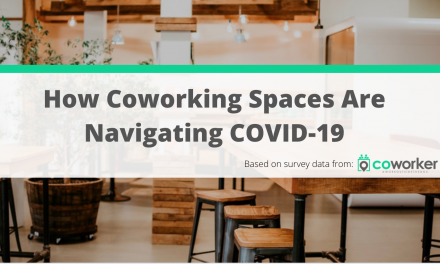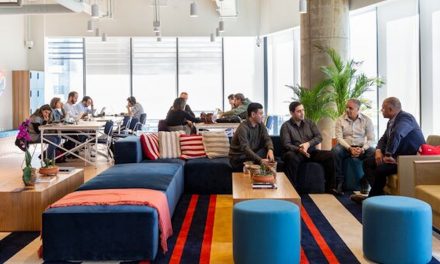The era of the old office is gone, as is the era of closed-off cubicles. In its place have come coworking spaces: unique and collaborative spaces that allow the free flow of ideas and the sharing of workspace in an economically cheap and eco-friendly manner.
While many companies are already using and enjoying coworking spaces to excellent effect, they can be further bolstered by machine learning and AI technologies. Today, let’s break down how coworking spaces can be improved by AI and look at how this novel technological field may lead coworking to become the business standard even more than it already is.
The Rise of Coworking Spaces
Coworking spaces have been around for over a decade, but only recently have they truly become a new gold standard for small startups, tech companies, and every business in between. In a nutshell, coworking spaces allow companies or freelance individuals to rent space for work. These spaces often include lots of excellent amenities, including high-speed Internet, on-demand coffee, and even gyms!
More and more often, full-on businesses are renting coworking spaces for their employees. Employees then use the coworking spaces to get any work done they can’t complete at home. They also use coworking spaces to:
- Meet with their bosses or fellow employees
- Enjoy some time outside the house
- Feel like they still go to the office even if they work for a nontraditional business or venture
Many coworking spaces are far superior to the office spaces that companies could otherwise provide. Plus, by using coworking spaces, companies save money – they don’t have to pay rent for expensive office buildings anymore.
Ways AI Will Improve Coworking Spaces
Although coworking spaces are already great, AI could improve them even further and make them even more attractive options compared to traditional office parks.
Automation of Maintenance Tasks
For example, AI will allow the automation of various maintenance tasks, such as shutting off lights or adjusting the thermostat when the weather changes. This minimizes the manual work that employees have to accomplish, allowing them to focus on collaborating, socializing, or taking care of other more important tasks.
AI can also enable instantaneous and reactive light and temperature adjustments for employees in a coworking space. For example, say that an employee is having difficulty seeing their computer screen because the sun is setting in the early afternoon.
AI can recognize this reaction through a camera, then turn up the light for that employee’s desk lamp automatically. This enables the employee to see their screen better and work more productively, all without them having to get up and ask for a manual light change.
By the same token, AI can detect when it’s time to increase or decrease the temperature based on productivity levels, the temperature outside, and more. That’s one less chore that a human has to tackle and more time that people can spend focusing on the goals and work that really matters. For instance, if more people in the coworking space are putting on extra shirts or jackets, a machine learning program could detect this and turn the temperature up a degree or two.
Scheduling Assistance
One of the big challenges faced when trying to maximize coworking functionality is scheduling. After all, even the most expensive coworking spaces only have a certain number of seats for everyone. Therefore, coworking space managers or supervisors have to schedule different seats or stations according to client requests and needs.
AI and machine learning technology can provide scheduling assistance by:
- Determining when people usually come into the coworking space and how many seats are needed
- Drawing up presumptive or predictive models for seat allocation
- Predicting how many people will arrive at a coworking space in a given day
- And more
All of this will, once more, take some of the busywork of running a coworking space or business away from humans. This scheduling can happen automatically and will maximize the available seating capacity for a coworking space beyond what may currently be possible.
Improved Workflows
Workflow management is a full-time job, which is why many managers find themselves spending an inordinate amount of time ensuring that benchmarks are reached, that employees know what they are supposed to be working on, and more.
AI tech and machine learning tools may help to improve workflows in coworking spaces by:
- Helping to allocate employees to work specific project goals or tasks
- Creating benchmarks and predicted completion schedules
Space Optimization
As noted above, coworking spaces are always limited by how many seats they have available. However, those seats and their arrangements are rarely optimized because humans have preferences, can be picky, or aren’t sure where to sit.
With machine learning and AI technology, coworking spaces can maximize their available seats. They can assign seats to people who haven’t yet arrived so that coworkers at the same company can collaborate next to each other. Or they can draw up space layouts for coworking space owners and employees to fit a few more seats into an area without compromising anyone’s privacy or comfort.
Office Space Design
This touches on another major benefit that we’ll likely see more commonly in the future: AI-driven office space design. The old model of cubicles, which enclose employees and prevent them from collaborating and which stop ideas from bouncing around the office, is gone. And good riddance!
However, even open office space plans are not always maximized for light transmission, for easy communication, and for employee mental health. For example, you don’t want an employee to be stuck in the corner with no view of the outside or of the sky, right?
New or remodeling coworking spaces could benefit from having AI and machine learning tools design office spaces for them. AI can bring a bunch of factors into the equation, such as access to natural light, proximity to the bathroom or the coffee station, and more to ensure that every employee or coworking space user has a great experience.
Not only will this maximize the space in a given building. It will also make certain coworking spaces even more attractive and profitable.
AR and VR Integrations
Lastly, AI will continue to revolutionize both augmented reality and virtual reality tech. By integrating with these tools, AI will enable employees to:
- Easily telecommute or have meetings with coworkers at a coworking space. Imagine being able to meet with your boss when they’re around the world in a virtual environment that looks like a classy office
- Use fully virtualized displays thanks to three projectors and laptops
- Connect securely to the cloud to let employees see products, components, and other objects while sitting comfortably in a coworking space
Summary
Ultimately, coworking is here to stay, and AI could make coworking even more attractive and profitable for both big brands and new startups alike. It will be interesting to see how AI and coworking evolve in tandem with one another in the years to come, especially as new innovations are made in both sectors.









